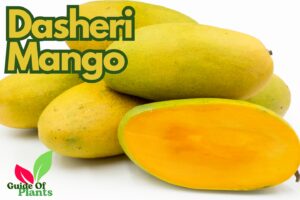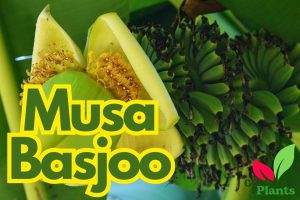The durian tree is a large, tropical fruit tree known for its extremely pungent and distinctive fruit. The word “durian” comes from the Malay word “duri” meaning thorn or spike, referring to the numerous spikes on the outer shell of the fruit.
The durian tree holds great ecological significance, as its fruit is a food source for various animals. Additionally, as a tall rainforest tree, it contributes to carbon sequestration and oxygen production. The durian is an important part of tropical ecosystems.
This blog will explore the singular scent and taste of the durian fruit, which evokes reactions ranging from delicious to revolting, making it one of the most polarizing fruits worldwide. The unique flavor and aroma of the fruit from the durian tree will be the focus.
Table of Contents
The Durian Tree, An Overview
The durian belongs to the genus Durio and species Zibethinus. The durian tree can grow up to 50 meters tall with a dome-shaped canopy. Its leaves are evergreen, oval-shaped, and dark green in color. The tree’s trunk is broad with light gray bark dotted with round fruit pods. The durian tree has distinctive physical features.
The durian is native to Southeast Asia, particularly Malaysia, Indonesia, and southern Thailand. While it originated there, durian is now grown in other tropical regions like Hawaii, the Caribbean, Africa, and northern Australia due to its popularity as an exotic fruit. The cultivation of the durian has spread beyond its native regions.

Also Know About: The White Mulberry Plant (Morus Alba)
Durian Fruit, Nature’s Unique Gift
A fully mature durian fruit from the durian tree can weigh two to seven pounds. Its shape ranges from oblong to round, with a hard, thorn-covered husk. The inside flesh is yellow to red in color. The fruit of the durian tree has a large size and distinctive spiky outer shell.
The durian has high vitamin C, potassium, vitamin B complex, and fiber. The seeds are rich in protein and fat. Durian tree fruit has many vitamins, minerals, and potential health benefits. Some studies have shown the durian may help lower blood pressure, reduce cholesterol, and act as an antioxidant. However, more research is needed to substantiate these potential health claims about the fruit of the durian tree.
Epic Flavor of Durian
The flesh of the durian tree‘s fruit has an exceptionally complex and unique flavor profile unlike any other fruit. It is known for its bittersweet combination of tastes including sweet, savory, bitter, sour, and fermented notes all in one bite. The flavored flesh has been described as tasting like a rich custard or buttercream with hints of almonds, chives, and roasted onions. Durian fruit connoisseurs highly prize the bittersweet complexity of its taste.
- Sweet and savory notes: Though the flavor is multilayered, the most pronounced tastes in durian fruit are sweet and savory. The sweetness comes from its natural sugars, while the savory umami taste is due to amino acids like glutamate. These flavors mingle to create a sweet yet salty, almost creamy flesh with a slightly bitter aftertaste. The fruit’s unique sweet-savory taste is unlike any other fruit.
- Creamy texture: In addition to its singular flavor, the flesh of the durian fruit has a smooth, custard-like texture punctuated by the occasional seed. It is soft and easily scooped out of the rind when ripe. The creamy, pudding-like consistency melts in the mouth. The natural richness of the durian tree‘s flesh gives it a velvety texture.
Culinary uses
The divisive scent yet irresistible flavor of durian tree fruit has inspired many culinary creations, both traditional and modern. Durian is commonly used in native Southeast Asian cuisines and has recently found its way into Western dishes as well.
- Traditional dishes: In Malaysia, Indonesia, and other parts of Southeast Asia, durian fruit is traditionally made into jams, candies, ice cream, and cakes. Durian sticky rice is a popular dessert made by mixing durian flesh with glutinous rice. Durian is also made into a savory soup called sour tempo yak, made sour and fermented from the seeds.
- Modern recipes incorporating durian: As durian has gained more popularity worldwide, modern chefs have come up with innovative ways to use the fruit. Durian cheesecake, mousse, macarons, and tiramisu are some Western-style takes. Blending durian into smoothies is also common. The fruit even appears in pizzas, pasta sauces, burgers, and alcoholic beverages like craft beers.

Also Know About: The Dasheri Mango: A Tropical Delight Worth Savoring
The Durian’s Signature Aroma
The durian tree‘s fruit is instantly recognizable by its infamously pungent aroma, which evokes reactions from deep love to intense disgust. The durian’s smell is so powerful that the fruit is even banned in certain public spaces.
Intensity of durian aroma
Durian fruit possesses one of the world’s most polarizing aromas – strong enough to be smelled from yards away. The stench released as the fruit ripens has been described as rotten, sulfurous, and skunk-like. Some even compare the odor to raw sewage, carrion, vomit, or stinky cheese. The powerful scent is difficult to mask.
Chemical compounds responsible for the smell
Research has identified a mix of chemical compounds behind the durian’s formidable fragrance. These include various volatile sulfur compounds like hydrogen sulfide, ethanethiol, and propanethiol, enzymes like putrescine and cadaverine, and esters including ethyl acetate. The precise combination and concentration of these odor molecules contribute to the fruit’s stench.
Cultural perceptions and attitudes towards durian aroma
Reactions to the infamous durian smell are culturally determined. Many Southeast Asians are lifelong devotees of the King of Fruit and find the stench appealing, associating it with the delicious flavor. However, those unfamiliar with durian often regard the odor as repulsive. Some hotels and public transport ban the fruit. But as durian gains global appeal, cultural perceptions of its smell are slowly changing as well.

Also Know About: Wild Strawberries
Harvesting and Processing Durian
The unique properties of the durian tree present challenges in harvesting and processing its precious fruit successfully. Specific techniques are required to collect the fragile durian pods and select only optimum ripeness. Post-harvest processing like storage and transport also needs special accommodations to preserve durian quality.
Harvesting practices
Timing the harvest of durian fruit requires careful skill. Durians only fall naturally from the tree once fully mature, typically 3-5 months after pollination. The fruit must be collected quickly once ripe, before overripening on the tree. Workers climb high into durian canopies to harvest the heavy, thorny fruits using long poles with attached baskets or nets.
Judging ripeness
Determining peak ripeness is critical for durian harvesting. Unripe fruit is inedible, while overripe durians quickly spoil. Experienced collectors judge ripeness by shaking pods and listening for seed movement inside. A subtle color change from light to darker green also indicates maturity. The ripeness aroma should be fruity and fragrant, not overly pungent.
Post-harvest handling
Careful post-harvest practices preserve durian quality. The fruits should not be piled or thrown during transport to avoid bruising. Proper storage conditions like cool temperatures slow ripening and fungal growth. For shipping, durians are often packed in foam boxes with ventilation holes to withstand transport without crushing.
Durian Tree Harvesting Challenges
While rewarding to cultivate, the durian also poses some difficulties for large-scale durian producers. Long propagation time, specific climate needs, large size, short flowering window, and short shelf life present production obstacles. Advanced horticulture techniques aim to improve durian crop yields and fruit quality.
- Lengthy propagation: Durian trees take 4-6 years from seed planting to first bear fruit. Grafting Durio rootstock can accelerate maturity, but still requires several years before generating harvests. The long wait until fruiting delays return on investment for durian orchards.
- Climate requirements: Durian trees thrive best in hot, humid equatorial climates with abundant rainfall. Ideal growing conditions are rare, limiting widespread commercial production. Durians are sensitive to drought and extreme heat which causes bitter, dry flesh and flower/fruit loss. Few regions provide optimal durian-growing climate.
- Massive tree size: Mature durian trees can tower up to 50 meters tall and 15 meters wide. Their large stature makes harvesting dangerous and difficult. Durian’s huge size also restricts high-density planting. New dwarf durian cultivars are being developed for easier picking and higher yields.
- Short flowering period: Durian trees only bloom for 2-3 days annually. The small flowering window limits pollination success and yield capabilities. Additionally, durians are self-incompatible, requiring cross-pollination between different clones for the fruit set. These factors further constrain durian production volumes.
- Short shelf life: Fresh durian fruit only remains usable for 2-4 days after harvest due to rapid ripening and susceptibility to rotting. The short shelf life makes timely transport to markets challenging. Refrigeration helps prolong storage life slightly, but also degrades flavor. Durian’s perishability leads to much waste.
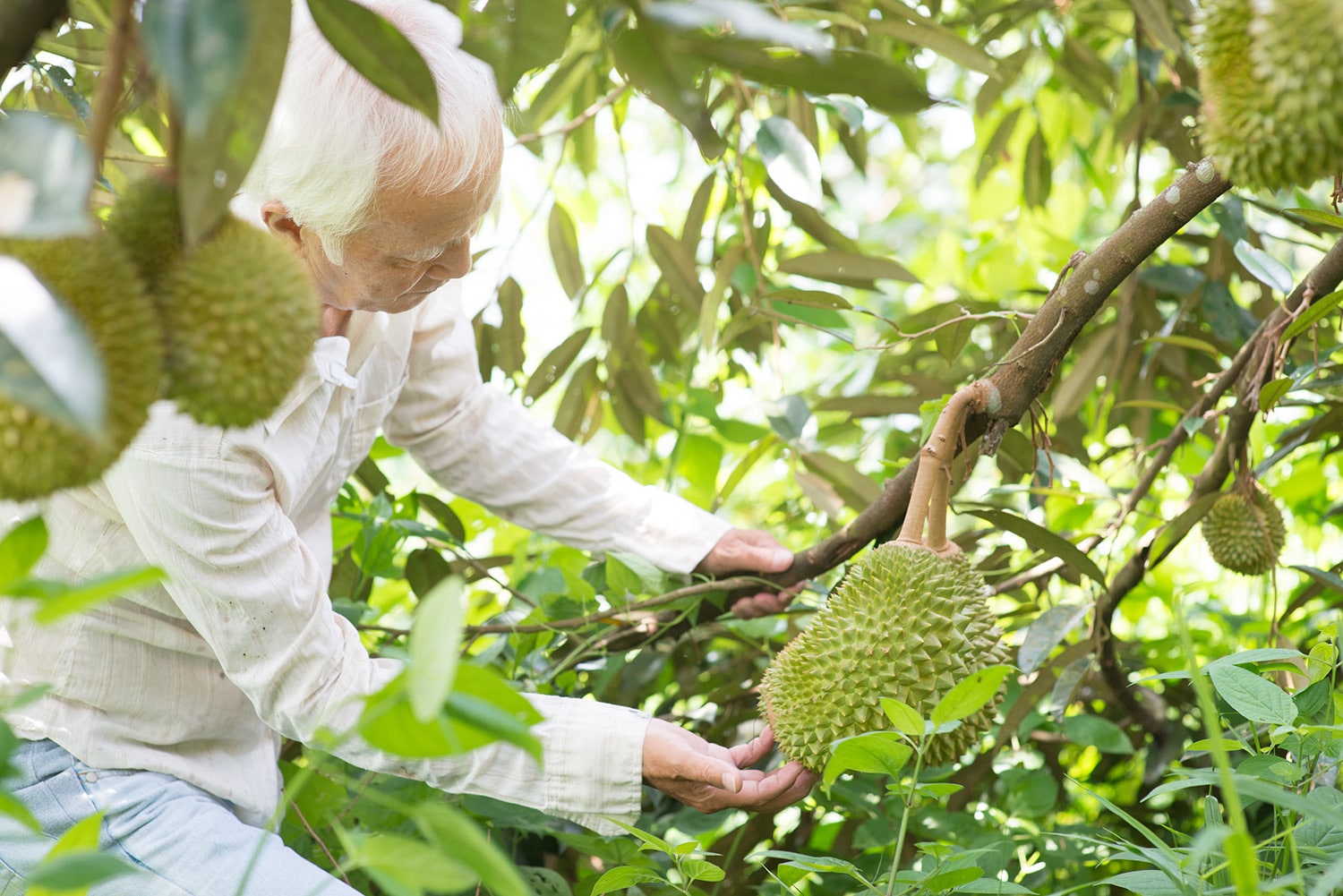
Health Benefits and Risks
The King of Fruit from the durian tree offers an impressive nutrient profile with potential therapeutic properties. However, overindulgence in the fruit’s richness may also pose some health hazards. Moderation is key to safely enjoying durian’s health perks.
Nutritional benefits: Durian fruit is packed with beneficial nutrition. It provides key vitamins like vitamin C, many B vitamins, vitamin E, and minerals such as manganese, copper, potassium, magnesium, iron, calcium, and phosphorus. Durian also contains antioxidants like carotenoids and flavonoids. These nutrients offer protective effects.
Medicinal qualities: Some research indicates compounds in durian may provide additional health effects. Durian’s tryptophan content helps serotonin production, which may relieve anxiety, stress, and sleep issues. Phytochemicals show anti-inflammatory, antimicrobial, and anticancer actions in studies. More clinical trials are still needed.
Potential adverse effects: However, the rich nature of durian means overeating may cause problems for some. Its high calorie and carbohydrate content can lead to blood sugar spikes and weight gain. Durian’s sulfur content can worsen bloating and indigestion issues. The fruit is also very high in potassium, which poses a risk for patients with kidney disease or on dialysis.
Challenges and Controversies
The durian tree’s fruit elicits sharply split opinions worldwide for its overpowering scent. While durian enthusiasts are deeply devoted to the King of Fruit’s flavor, many others find the odor repulsive and impossible to tolerate. Durian’s polarizing nature creates challenges in public settings.
The pungent aroma leads some public locations to regulate or prohibit durians. Many hotels, mass transit systems, airports, and office buildings in Southeast Asia ban the fruit. Singapore’s strict durian rules fine anyone carrying it on public transportation or leaving the scent in common areas.
Enjoying durian requires strategies to overcome its infamous odor. Picking less ripe fruit, proper storage techniques, and consuming it outdoors can reduce the scent impact on bystanders. For export markets, flash-freezing or durian-flavored products give a taste without the smell. Durian aficionados worldwide employ creative solutions to savor their beloved fruit.
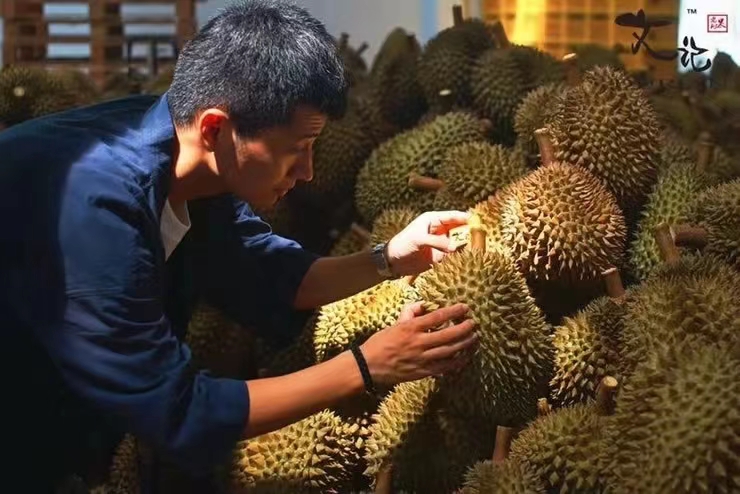
Also Know About: Dragon Fruit Plant: Facts For Growing This Superfood in 2023
Durian Tree Conservation
Protecting wild durian populations is crucial since the species faces habitat loss and climate threats. As a top canopy tree, durians play a vital ecological role in rainforests. Conserving durian biodiversity also preserves genetic diversity for future breeding.
Deforestation for agriculture and development destroys native durian forest habitat, especially lowland areas ideal for durians. Loggers target the valuable timber. Climate change impacts like drought, unpredictable rainfall, and rising temperatures also endanger durians. Pest outbreaks facilitated by climate shifts affect production.
Several measures aim to protect durian trees. Forest conservation, especially in protected areas and national parks, preserves wild durian populations and genetic stock. Durian seed banks, breeding programs, and germplasm repositories aid conservation. Meanwhile, cultivating durians sustainably, like through organic production, reduces pressure on forests. Public education also promotes conservation of the iconic durian tree.
The Durian Tree and Culture
The distinctive durian permeates the cultures and traditions of Southeast Asia where it originates. Durian has become interwoven into the region’s cuisine, festivals, folklore, and traditions. The King of Fruit holds an esteemed status as a cultural symbol.
Durian is integral to the cuisines of Southeast Asia. It is made into desserts, candies, cakes, jams, and ice cream or paired with glutinous rice. Durians flavor a wide range of regional curries, stir fries, and soups. Locals and tourists flock to durian stalls, hotels, and plantations to enjoy fresh durians.
The durian is featured in legends and folk tales across Malaysia, Indonesia, and beyond. Some stories explain the origin of the durian fruit with fantastical accounts of its creation. Other myths feature spirits and giants interacting with durian trees. These tales showcase the cultural prominence of durian.
Durian festivals occur during peak harvest season in durian-growing regions. At these celebrations, locals showcase prized durian varieties in competitions and enjoy durian feasts. The festivals also include cultural performances, beauty pageants, and carnival rides in honor of the beloved fruit. For instance, a major durian festival is held annually in Bao Loc, Vietnam.
The durian has become deeply rooted in Southeast Asian cultural identity thanks to its singular fruit. Durian transcends being just a food – it is an icon intertwined with regional traditions, stories, and pride.
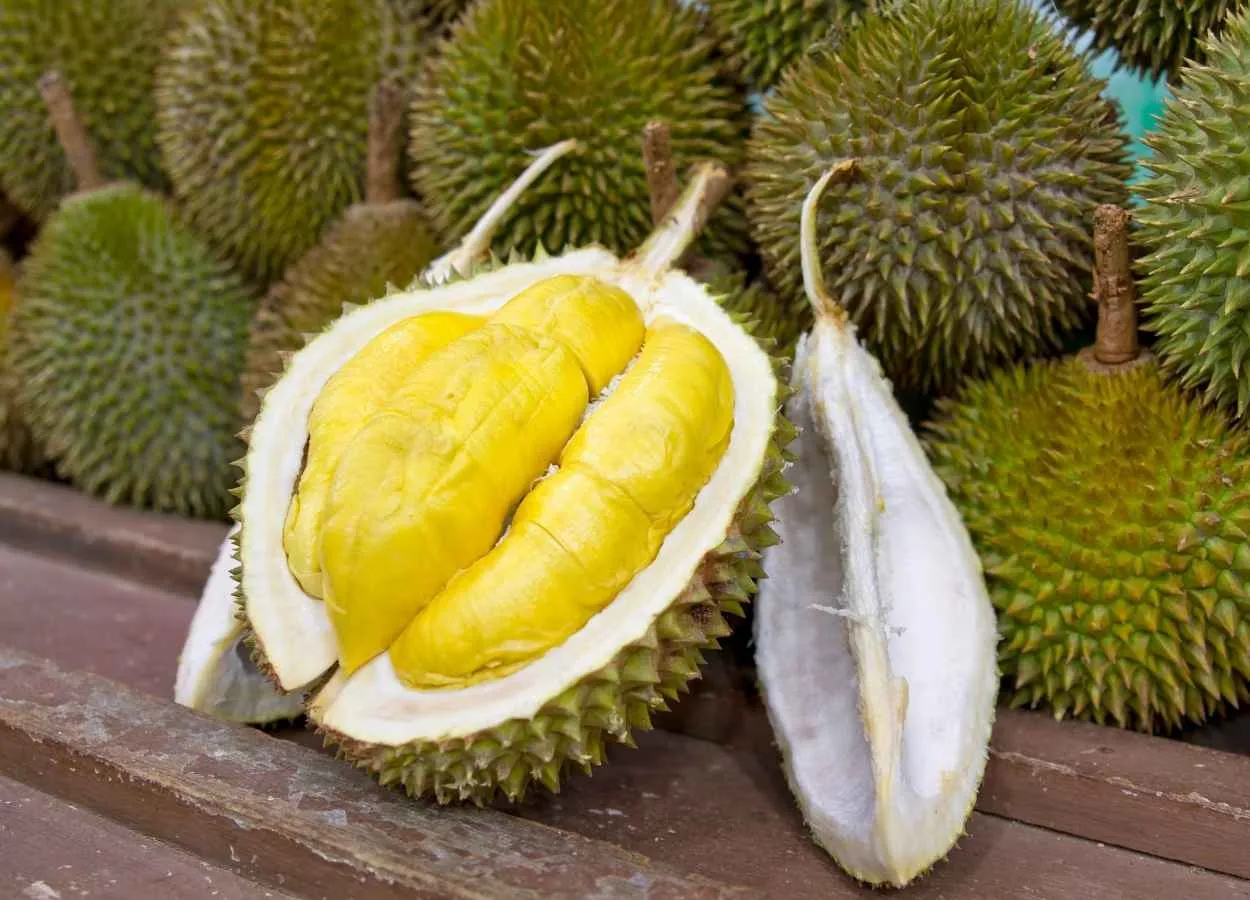
Also Know About: Musa Basjoo (Hardy Banana)
Conclusion
The durian tree is truly one of a kind, from its thorny fruit pods to the pungent yet addictive flavor and aroma of the durian fruit inside. This tropical tree holds an important ecological role while also producing an exceptional fruit that has become a cultural icon.
While many find the durian’s odor challenging, its complex flavor is unmatched and irresistible to aficionados. The custardy, bittersweet taste and smooth texture create an indulgent eating experience worshiped across Southeast Asia and beyond. The durian tree deserves appreciation for yielding this King of Fruits.
As demand for durian grows worldwide, it is crucial that durian orchards are managed sustainably without destroying rainforest habitat. Consumers should seek out ethically produced durian. We must protect the future of the precious durian tree and its one-of-a-kind fruit.
Additional Resources
For those interested in the technical details of the durian tree and fruit, here are links to peer-reviewed studies on durian genetics, biochemistry, and health effects: [links]
To further explore the cultural and culinary world of durians, check out these books, films, and shows: [recommendations]
Ready to cook with durian yourself? Get creative inspiration from these websites with recipes ranging from savory mains to sweet desserts: [links]
Acknowledgments
I appreciate you taking the time to learn more about the exceptional durian tree and its fruit through this blog. Developing a better understanding of this polarizing food engenders more respect.
I welcome any comments, questions, personal stories, or feedback related to durian. Let’s have an open discussion about this unique plant and fruit.
Finally, I would like to express my gratitude to the researchers, growers, chefs, and durian enthusiasts worldwide whose work contributed information to this blog. Your expertise and passion have shed fascinating light on the King of Fruits.
What is a durian tree?
The durian tree is a large, tropical fruit tree that is native to Southeast Asia. It’s known for producing the distinctive durian fruit, which is famous for its strong odor and unique flavor. The durian tree can grow very tall, up to 50 meters, and has thorn-covered pods containing the durian fruits.
What does durian fruit taste like?
Durian fruit has a very complex flavor that is often described as sweet, creamy, and savory. The soft, custard-like flesh has notes of almond, vanilla, roasted onions, and a slightly bitter aftertaste. Durian is renowned for its rich texture and bittersweet taste that aficionados find irresistible.
Is durian good for you?
Yes, durian fruit is highly nutritious. It contains healthy fats, carbohydrates, dietary fiber, and several vitamins and minerals like vitamin C, B vitamins, manganese, and potassium. Durian also provides plant compounds with antioxidant properties. In small amounts, it can be part of a balanced diet.
Where is durian banned?
Many public places ban durian fruit due to its infamous odor, including public transit, hotels, airports, shopping malls, and schools across Southeast Asia. Singapore has very strict rules prohibiting durians on public transport and in public buildings due to complaints over the lingering smell.
How do you eat durian fruit?
Fresh durian is best consumed raw directly after opening. Use a knife to cut around the middle seam, open up the thorny rind, and scoop out the flesh pods inside. The smooth, creamy texture lends itself well to desserts. Durian is also commonly used in candies, ice cream, cakes, milkshakes, and traditional Southeast Asian dishes.


